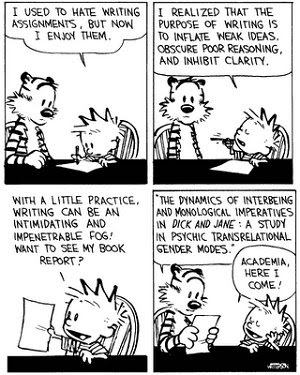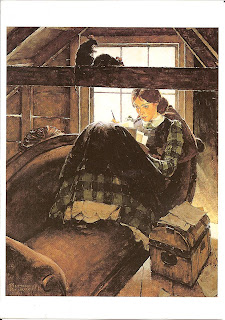Note: some of the thoughts below come from Randy Ingermanson's excellent book, Writing Fiction for Dummies. If you're interested in reading more about POV, be sure to check it out!
1. First Person
-- What it is: write from inside the head of one character, using the pronoun "I". For example, "I walked into the street and looked around for Karla. 'What's taking her so long?' I wondered. Just then, someone clapped a hand over my mouth." You stay inside that character's head, seeing their thoughts and reactions, for the entire scene.-- Benefits: It's extremely close and personal, allowing readers to connect easily with the character.
-- Drawbacks: You can only use first person for one person per scene, and when you're looking from that character's view, you can't write anything that the character wouldn't know. Plus, if you change around the point of view characters in different chapters or sections, the characters can start to sound alike unless you're careful to make their thoughts sound different. Lastly, the first person voice can be too close and personal for some readers, who would prefer distance.
2. Second Person
-- What it is: write from inside the head of one character, using the pronoun "you." For example, "You walked into the street and looked around for Karla. 'What's taking her so long?' you wondered. Just then, someone clapped a hand over your mouth." In 2nd person, you can choose whether or not to show the character's thoughts (as I did in the example above).-- Benefits: it's unusual, so it will catch a reader's attention right away.
-- Drawbacks: It's even more personal than first person because, in a way, it feels as though you are a character in the story. So if the narrator in the story (the 'you' character) does something the reader wouldn't do, than the reader will almost certainly balk and stop reading. Also, because it's so rare, readers aren't used to reading it, so readers may give up after trying to read a little.
3. Third Person (Limited)
-- What it is: write from inside the head of one character, using the pronoun "he/she." For example, "He walked into the street and looked around for Karla. 'What's taking her so long?' he wondered. Just then, someone clapped a hand over his mouth." Again, as with first and second person point of view, you can only show/tell what the character is thinking, seeing, or experiencing.-- Benefits: it's still fairly close and personal, allowing readers to connect with the character.
-- Drawbacks: again, you must stay within that one character's head during the entire scene. Plus, it can seem slightly more distant than first person, depending on how often you introduce the character's thoughts into the story.
4. Omniscient
-- What it is: write from inside or outside the heads of multiple characters, or write from the perspective of a god-like persona who knows what's going on in and out of everyone's heads. For example, "Jimmy was a paranoid man. As he stepped into the street, he glanced nervously around, wondering where Karla went. Across the street in a parked car, Karla fiddled with her nails. Although normally a calm woman, she could not help but wonder what was taking Jimmy so long. Then, a man dressed in black clapped his hand over Jimmy's mouth."-- Benefits: your readers know what's going on in and out of most characters in the story, including the villain. This can be helpful in some scenes (although often it's simply confusing).
-- Drawbacks: Omniscient point of view tempts authors to add in little bits of explanation and inner thoughts that aren't strictly necessary. One note of warning: few modern authors write in omniscient point of view, especially as it's very close to the very confusing head-hopping view (see point 6). For an example of effective usage, see The Godfather by Mario Puzo, or portions of Dune by Frank Herbert.
5. Objective
-- What it is: write from outside the head of a focal character or characters, using the pronoun "he/she." In this point of view, the reader never gets to see anyone's thoughts. It's very scientific and, as the name signifies, objective. For example, "Jimmy stepped into the street. Karla waited in a car across the street. Suddenly, a man in black clapped his hand over Jimmy's mouth."-- Benefits: if you're going for a scientific feeling, then this view can be helpful. It makes the story very visual, almost as though there's a movie camera filming the scene.
-- Drawbacks: you can't use inter emotions or show the inner thoughts of any of the characters, so the characters can feel extremely remote from your reader. And when writing in this point of view, don't cheat by having the characters voice their thoughts in a phony way.
6. Head-Hopping
-- What it is: write from inside the heads of multiple characters in the same scene, using the pronoun "he/she." For example, "As Jimmy stepped into the street, he thought, 'Karla isn't waiting for me. But where could she be?' Karla, sitting in the car, bit her fingernail and wondered, 'Jimmy's sure takin' a long time. Wonder what got into him?'"-- Benefits: the readers know what everyone in a scene is thinking.
-- Drawbacks: Humans find it easiest to identify with one character at a time. Head-hopping can become confusing and distracting, and makes the story less vivid and precise for your reader. This method of narration is highly discouraged by most writing teachers. However, there are still plenty of novels that head-hop a good deal (Gone with the Wind, by Margaret Mitchell, for one).
<><><><><><><><>
Hope you enjoyed that (not-so-short) summary of points of view! Now, what about you? What point of view is your current story written in? Have you ever tried writing it in a different point of view?
 |
| Sweet Halloween Dreams, by begemot on Deviantart |







